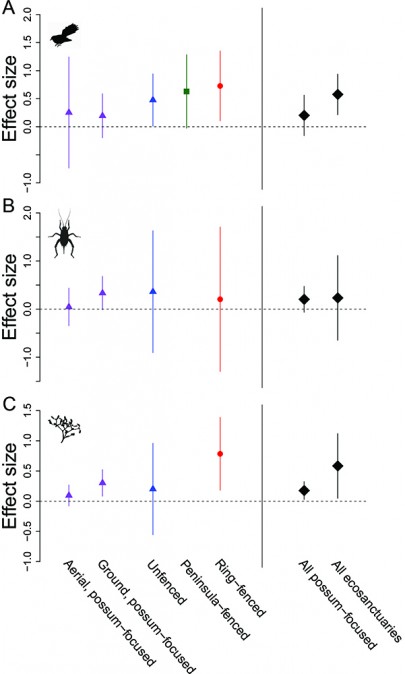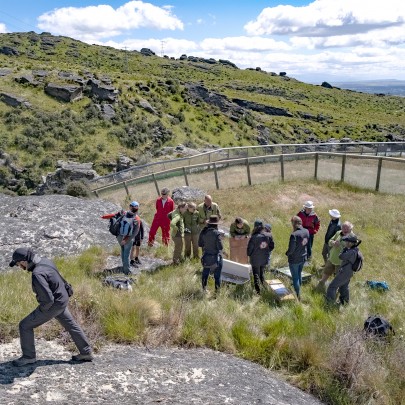Biodiversity outcomes in ecosanctuaries
Researchers from Manaaki Whenua – Landcare Research (MWLR) Rachelle Binny, John Innes, Andrea Byrom (New Zealand’s Biological Heritage National Science Challenge), Neil Fitzgerald, Robbie Price and Roger Pech recently joined forces with researchers at the Department of Conservation (DOC), University of Canterbury, and Te Pūnaha Matatini to undertake a national meta-analysis (a technique that combines the results of several independent studies to answer big questions) of ecosanctuaries and their biodiversity outcomes. Over the past 17 years MWLR has run annual ecosanctuary workshops to facilitate contact between practitioners and act as a conduit for science into the national ecosanctuary network. The relationships established through these meetings laid the foundations for a data-sharing collaboration among 27 ecosanctuaries, including projects led by community trusts, regional councils, and DOC, who contributed close to 80 biodiversity data sets surveying hundreds of species for this national meta-analysis.
National meta-analysis
By combining data across a large number of projects, the team were able to compare the broad biodiversity trends occurring under five major regimes of pest control on New Zealand’s mainland: (1) ring-fenced ecosanctuaries, where all small mammal pests (typically except mice) have been eradicated; (2) peninsula-fenced ecosanctuaries that achieve initial eradication then must protect against reincursions via the fence ends; (3) unfenced mainland islands where pest numbers are suppressed to varying degrees; (4) large-scale aerial possum-focused control (e.g. using 1080 toxin); and (5) large-scale ground-based possum-focused control (e.g. trapping and/or poisoning). The first three regimes are intensive and costly approaches to pest control and typically cover small areas between 25 ha and 3400 ha. The fourth and fifth regimes are less intensive but can cover much larger areas, over 10,000 ha.
The meta-analysis used 447 biodiversity response measures (e.g. bird, invertebrate or seedling counts) from 16 ecosanctuaries: four ring-fenced, three peninsula-fenced, and nine unfenced mainland islands. From each response measure an ‘effect size’ was calculated for each year since the start of intensive multi-species pest control, up to a maximum of 20 years. This effect size measures the size of biodiversity benefit from pest control relative to doing no control. A total of 3543 effect sizes were combined in order to show the overall biodiversity benefit across multiple projects.
Do native flora and fauna benefit from control?

Figure 1: Biodiversity benefits in ecosanctuaries are generally greater than for large-scale possum-focused pest control.The graph shows mean effect
size estimates and 95% confidence intervals (CIs) for (A) native birds (up to 4 years of control), (B) invertebrates (up to 6 years of control), and (C) mammal-sensitive vegetation (up to 11 years of control), under five regimes. When this effect size is a positive number it indicates a benefit from pest control, an effect size of zero indicates pest control is having no effect, and a negative effect size indicates a negative response to pest control. The dashed black line indicates no effect of pest control. CIs intersecting zero indicate no statistically significant difference from a zero effect.
The team found strong evidence of the long-term benefits of pest control for native birds, invertebrates, and vegetation in all five regimes (Figure 1). The greatest benefits were found in fenced ecosanctuaries where pests had been eradicated. Under regimes where pests were suppressed, ecosanctuaries conferred greater benefits for birds and vegetation, albeit over a smaller management area, than did large-scale, possum-focused control regimes. In all ecosanctuary types, bird populations recovered most rapidly over the first 5 years of sustained pest control. After this time the effect sizes levelled off in unfenced mainland islands but continued to grow each year in fenced ecosanctuaries.
Deeply endemic bird species (those unique to New Zealand and have evolved here longest) are particularly vulnerable to pests because of traits such as flightlessness, ground nesting, and highly specialised diet. The team compared outcomes for deep endemic bird species (e.g. kiwi, hihi, kōkako) with more recent native species (species whose ancestors arrived in New Zealand more recently, but which are also found elsewhere in the world, such as silvereye) and with introduced species (e.g. chaffinch). Deep endemics had most to gain from pest control, with complete eradication or sustained suppression of pests to very low levels providing the best outcomes. There were smaller or no benefits for recent natives, which are generally less sensitive to pests. After about 7 years of being pest-free, deep endemics were abundant enough to out-compete exotic bird species, and populations of the latter typically declined.
Results within invertebrate communities were more of a mixed bag. Pest control benefited some endemic invertebrates such as wētā, while other invertebrate groups, such as beetles, declined. These declines might be due to increased predation by recovering bird populations or by non-targeted pest species such as mice, which are frequently found at higher densities in intensively pest-managed projects.
For native vegetation, the benefits of pest control were mainly found in species that are sensitive to small mammals; for example, those that suffer over-browsing of foliage by possums or seed damage by ship rats. As plant communities establish and progress through successional stages, their changing structure promotes the survival of different species and ecosystem services (i.e. the benefits of healthy ecosystems, such as pollination or soil formation). Restoration of vegetation is therefore a fundamental building block for ecosystem recovery, and the enhancement of vegetation within ecosanctuaries will also be contributing to the benefits found in bird and invertebrate communities. Richness (the number of species present) of native bird species was highest in fenced ecosanctuaries, while projects with large components of human-modified open-country habitat favoured exotic bird species.
Knowledge gaps
The review revealed some important knowledge gaps in ecosanctuary monitoring. Most long-term monitoring studies were of bird populations, while other taxa were under-represented. In particular, further monitoring is needed to clarify outcomes for frogs and lizards. These species are particularly vulnerable to predation by house mice, and other studies have suggested that lizards may only benefit from pest control if low mouse densities are achieved. This has important implications, particularly for fenced ecosanctuaries where mouse densities are typically high. Where invertebrate, lizard, and vegetation monitoring had been done, it was often only within the pest-managed area or was started after pest control began. This meant changes in managed populations couldn’t be benchmarked against changes in unmanaged areas. The effects of other mammalian predators, including feral cats and hedgehogs, within unfenced mainland islands couldn’t be measured due to a lack of standardised monitoring.
Management implications

Mokomoko Dryland Sanctuary
The findings from this study provide extensive new evidence that invasive pest control is an effective, often essential, approach to restoration and that eradication is the most effective regime for achieving biodiversity benefits. This is important for confirming whether conservation objectives are being achieved, and for justifying the use of resources or approaches to pest management, both within individual projects and at national level. Tracking the trajectories of restoration over time also informs decisions on when active management (e.g. translocations, plantings or pest control) should be maintained, intensified or scaled back. The study revealed how much pest control is needed to benefit different taxa by assessing the relationship between the density of ship rats that remained in ecosanctuaries after pest control with the outcomes that were achieved for endemics, recent natives, and introduced bird species. In general, a threshold of 15% post-control ship-rat tracking index (an average over the season immediately prior to the biodiversity survey) should be achieved in order to observe a benefit to bird species, and benefits increase as indices approach 0%. However, this threshold will differ for specific bird species, and this is a focus of current work by the team.
As New Zealand works towards becoming predator free by 2050, an understanding of the relative benefits of pest eradication versus suppression will be critical for designing an effective national strategy for the restoration on New Zealand’s mainland. While new approaches capable of achieving and maintaining pest eradication at very large spatial scales are developed, the results of this study inform decisions about where and when we should aim for eradication to safeguard New Zealand’s most vulnerable species and where less vulnerable species can be sufficiently protected under suppression-focused regimes, which are less intensive but can cover much larger areas.
Funding
This work was funded by the Ministry of Business, Innovation and Employment. The team is grateful to the 27 ecosanctuaries for sharing data for these analyses, and to the wider ecosanctuary community for their support of this work; full acknowledgements are provided in the papers noted at the end of this issue of Kararehe Kino.
Key contact

